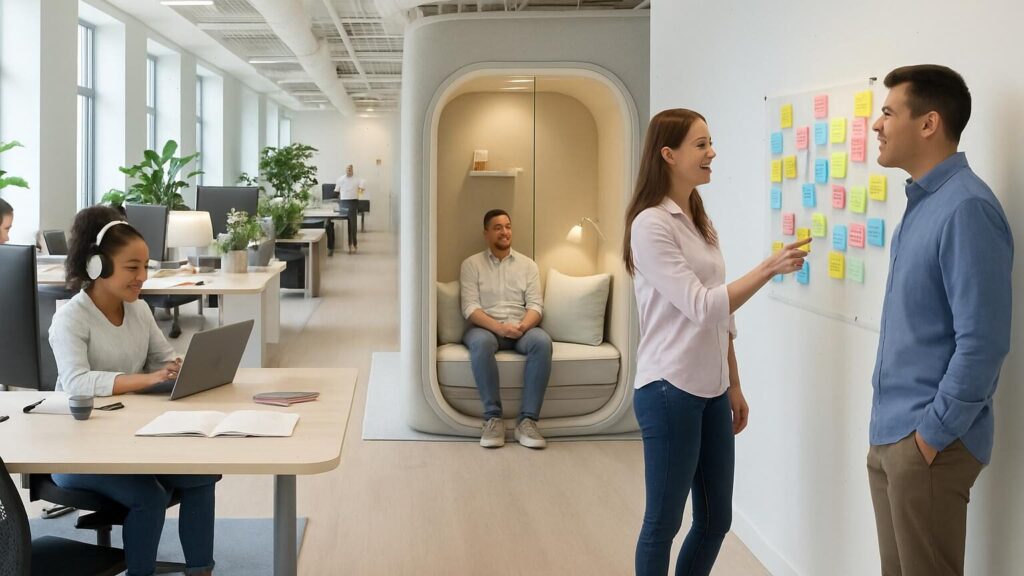
Autism Spectrum Disorder (ASD) is a complex neurodevelopmental condition that can influence how individuals communicate, behave, and interact with their surroundings. While typically associated with children, many adults also live with ASD, undertaking the challenges of everyday life, including their professional endeavors. For these adults, seeking and maintaining employment can be uniquely challenging, as traditional workplace structures often fail to meet their specific needs. However, creating workplaces that embrace neurodiversity is both a moral responsibility and a strategic advantage. By accommodating neurodiverse individuals, organizations can tap into a wealth of diverse perspectives and talents, fostering an environment where employees feel acknowledged and valued, while benefiting from the distinctive contributions and dedication of their neurodiverse staff.
Understanding Neurodiversity in the Workplace
Neurodiversity acknowledges that neurological variations, such as autism, ADHD, and dyslexia, are inherent to human diversity. These differences, when embraced, can significantly enhance workplace dynamics. Nevertheless, conventional work settings frequently pose hurdles for autistic individuals, who might find open offices overwhelming or struggle with unspoken social norms. Misunderstandings often stem from a lack of awareness, leading to underutilized talents and potential conflicts. Recognizing these challenges is the first step toward crafting supportive and accommodating environments where neurodiverse employees can flourish.
Creating a Make Your Workplace Autism Friendly Environment
Fostering an autism-friendly workplace begins with practical adjustments to the physical environment. Soft, natural lighting is preferable, as harsh fluorescent lights can be distressing for some individuals. Controlling noise levels is crucial; offering noise-canceling headphones or designated quiet zones can help minimize sensory overload. Workspaces should be flexible, allowing employees to tailor their environments to meet sensory preferences. Technological supports are equally important; assistive tools like text-to-speech software or time-management apps can be instrumental in helping autistic employees manage their tasks. Additionally, clear digital communication tools, such as structured email templates and user-friendly platforms, can reduce misunderstandings and boost productivity.
Inclusive Practices for Neurodiverse Individuals
Inclusive practices in the workplace start with recruitment and hiring processes that mitigate bias. Job descriptions should emphasize necessary skills and outcomes instead of rigid qualifications. Interviews should be adaptable, accommodating different communication styles, such as written responses. Partnering with organizations specializing in neurodiverse hiring can offer valuable insights and support. Once hired, continuous training for all staff on neurodiversity fosters an inclusive culture. Personal development plans should capitalize on individual strengths, offering growth opportunities aligned with each employee’s unique capabilities. By focusing on potential rather than limitations, organizations can cultivate a more inclusive and equitable work culture.
Fostering Inclusivity for Neurodiversity
Open dialogue about neurodiversity is essential for fostering inclusivity. Establishing support networks and employee resource groups can raise awareness and share experiences. Leadership plays a pivotal role in this endeavor; commitment from the top can initiate cultural change throughout the organization. By promoting and supporting inclusivity initiatives, leaders demonstrate their dedication to creating an environment where neurodiverse individuals feel respected and empowered. These efforts dismantle barriers and build a cohesive community where everyone has the opportunity to contribute and succeed.
Embracing Neurodiversity in the Community
Beyond the workplace, organizations can extend their embrace of neurodiversity through community outreach and partnerships with autism advocacy groups. Engaging in awareness campaigns and community events helps to dismantle societal stereotypes and promote acceptance. Sharing success stories of neurodiverse employees can inspire others and showcase the positive impact inclusivity has on both individuals and organizations. By broadening their efforts to include neurodiversity outside the workplace, companies play a proactive role in fostering a more inclusive society and building connections with their communities.
Neurodiversity and Healthy Communication
Effective communication strategies ensure all employees, including those who are neurodiverse, can fully participate in the workplace. Clear, direct, and specific communication methods avert ambiguity and ensure understanding of roles and responsibilities. Providing both written and verbal instructions accommodates different learning styles and preferences. Building emotional connections through empathy and understanding is equally important. Encouraging team members to appreciate and respect diverse communication styles fosters a collaborative environment where everyone feels heard and valued.
Improving Communication with Autistic Partners
Tailoring communication to meet the individual preferences and needs of autistic partners is essential. Some may prefer written communication for clarity, while others might appreciate face-to-face interactions. Creating a safe space for feedback and expression allows partners to voice their thoughts and concerns without judgment. By actively listening and adapting communication strategies, organizations can ensure that all voices are respected and considered.
Empowering Neurodiverse Individuals in Their Partnerships
Empowering neurodiverse individuals in professional relationships involves supporting self-advocacy and fostering collaboration. Valuing the unique insights neurodiverse employees offer enriches the organization as a whole. Encouraging open discussions and providing opportunities for neurodiverse individuals to contribute to decision-making can lead to innovative solutions and ideas. By celebrating diversity, organizations create an inclusive and dynamic environment where everyone has the chance to thrive.
Conclusion
Creating an autism-friendly workplace brings numerous benefits, from enhanced employee satisfaction and retention to innovative ideas and an improved company culture. Organizations are encouraged to evaluate their current practices and seek ways to enhance inclusivity. Even small changes can lead to a more welcoming and supportive environment for neurodiverse individuals. By accessing resources for further learning and development on neurodiversity, organizations can embark on this crucial journey toward inclusivity, ensuring a thriving, diverse workforce.




